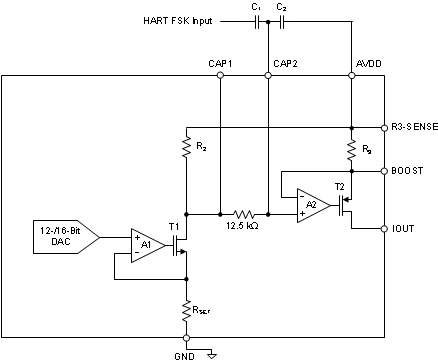ZHCSC70D December 2013 – December 2021 DAC7750 , DAC8750
PRODUCTION DATA
- 1 特性
- 2 应用
- 3 说明
- 4 Revision History
- 5 Device Comparison Table
- 6 Pin Configuration and Functions
- 7 Specifications
- 8 Detailed Description
- 9 Application and Implementation
- 10Power Supply Recommendations
- 11Layout
- 12Device and Documentation Support
- 13Mechanical, Packaging, and Orderable Information
封装选项
机械数据 (封装 | 引脚)
散热焊盘机械数据 (封装 | 引脚)
订购信息
9.1.1.1 Using the CAP2 Pin
The first method to implement HART is to couple the signal through the CAP2 pin, as shown in Figure 9-1.
 Figure 9-1 Implementing HART on IOUT
Using the CAP2 Pin
Figure 9-1 Implementing HART on IOUT
Using the CAP2 PinIn Figure 9-1, R3 is nominally 40 Ω, and R2 depends on the current output range (set by the RANGE bits), described as follows:
- 4-mA to 20-mA range: R2 = 2.4 kΩ (typical)
- 0-mA to 20-mA range: R2 = 3 kΩ (typical)
- 0-mA to 24-mA range: R2 = 3.6 kΩ (typical)
The purpose of the 12.5-kΩ resistor is to create a filter when CAP1 and CAP2 are used.
To insert the external HART signal on the CAP2
pin, an external ac-coupling capacitor is typically connected to CAP2. The high-pass
filter 3-dB frequency is determined by the resistive impedance looking into
CAP2 (R2 + 12.5 kΩ) and the
coupling-capacitor value. The 3-dB frequency is 1 / (2 × π × [R2 + 12.5
kΩ] × [Coupling Capacitor Value]).
When the input HART frequency is greater than the 3-dB frequency, the ac signal is seen at the plus input of amplifier A2, and is therefore seen across the 40-Ω resistor. To generate a 1-mA signal on the output therefore requires a 40-mV peak-to-peak signal on CAP2. Most HART modems do not output a 40-mV signal; therefore, a capacitive divider is used in Figure 9-1 to attenuate the FSK signal from the modem. In Figure 9-1, the high-pass cutoff frequency is 1 / (2 × π × [R2+ 12.5 kΩ] × [C1 + C2]). There is one disadvantage to this approach: if the AVDD supply is not clean, any ripple on the supply could couple into the device.